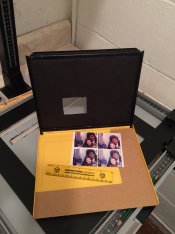rpavich
Member
So I started printing color a few days ago and after my first success (relatively speaking) I hit the darkroom to go at it again and was underwhelmed with my results. I think I just hit on a more difficult negative than the first time so I had an exaggerated sense of how balancing the color would go.
I'm using the Kodak viewing filters for reference.
Example.
I had a keepsake negative from when my stepson shipped out to Europe and tried printing it. It was VERY orange/yellow. I started increasing the M and Y filters and got to a point where I thought I nailed it as well as I could but in getting up this morning and seeing the results, I definitely overshot it...it's too green. Skin tones look sickly.
Most of the time my images are family snap shots so elaborate set ups like shooting a grey reference card every time isn't feasible.
Just looking for folks who've been through it and have tips to ease my pain
From top to bottom is the sequence. The pictures don't look exactly like they do in real life. In real life they are more reddish and the second to last one is not as green as it looks here. The last one is greenish.

I'm using the Kodak viewing filters for reference.
Example.
I had a keepsake negative from when my stepson shipped out to Europe and tried printing it. It was VERY orange/yellow. I started increasing the M and Y filters and got to a point where I thought I nailed it as well as I could but in getting up this morning and seeing the results, I definitely overshot it...it's too green. Skin tones look sickly.
Most of the time my images are family snap shots so elaborate set ups like shooting a grey reference card every time isn't feasible.
Just looking for folks who've been through it and have tips to ease my pain

From top to bottom is the sequence. The pictures don't look exactly like they do in real life. In real life they are more reddish and the second to last one is not as green as it looks here. The last one is greenish.











